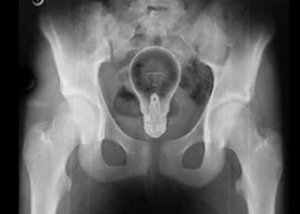
All iLive content is medically reviewed or fact checked to ensure as much factual accuracy as possible.
We have strict sourcing guidelines and only link to reputable media sites, academic research institutions and, whenever possible, medically peer reviewed studies. Note that the numbers in parentheses ([1], [2], etc.) are clickable links to these studies.
If you feel that any of our content is inaccurate, out-of-date, or otherwise questionable, please select it and press Ctrl + Enter.
Rectal foreign bodies
Medical expert of the article
Last reviewed: 07.07.2025

Gallstones, coprolites, and swallowed foreign bodies (including toothpicks, chicken and fish bones) may become retained in the anorectal area.
Urinary stones, vaginal pessaries, surgical sponges or instruments may be found in the rectum. Rectal foreign bodies, sometimes unusual and/or related to sexual play, may be introduced into the rectum intentionally but often become difficult to remove. Some foreign bodies penetrate the rectal wall, others migrate above the anal sphincter.
Symptoms of foreign bodies in the rectum
Sudden, excruciating pain during defecation should raise suspicion of penetration of a foreign body, usually located at or above the anorectal junction. Other manifestations depend on the size and shape of the foreign body, the length of time it has been in the rectum, and the development of infection or perforation.
Diagnostics of foreign bodies in the rectum
Foreign bodies are usually localized in the middle part of the rectum, in the area of the anterior curvature of the rectum, which they cannot overcome. They can be palpated during digital examination. Examination of the abdominal cavity and radiography are necessary to exclude possible intra-abdominal perforation of the rectum.
Removal of foreign bodies from the rectum
If the foreign body can be palpated, local anesthesia is administered by subcutaneous and submucosal injection of 0.5% lidocaine or bupivacaine. The anus is dilated with a rectal retractor, and the foreign body is grasped and removed. If the foreign body cannot be palpated, the patient should be hospitalized. Peristalsis usually moves the foreign body inferiorly to the midrectum, which then allows removal of the object. Removal of a rectal foreign body with a sigmoidoscope or rectoscope is rarely successful, and sigmoidoscopy usually causes the foreign body to migrate more proximally, delaying its removal. Regional or general anesthesia, laparotomy with extrusion of the foreign body toward the anus, or colotomy with removal of the foreign body are rarely used. After removal of the foreign body, sigmoidoscopy should be performed to exclude rectal trauma or perforation. Removal of a foreign body from the rectum can be high risk and should be performed by a surgeon or gastroenterologist experienced in foreign body removal.


 [
[